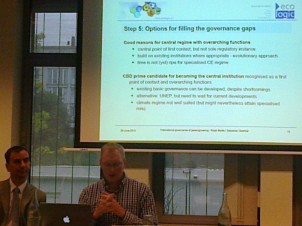
At the environmental policy forum “The International Governance of Climate Engineering”, held by The Institute for European Studies in Brussels on June 28, opinions differed on how European policymakers should react to the emerging field of climate engineering. Climate engineering refers to the deliberate intervention in the climate system to counter the effects of climate change (e.g. through blocking/reducing solar radiation in the upper atmosphere or enhancing the uptake of carbon dioxide through ocean ‘fertilization’).
Ralph Bodle, Senior Fellow at the Ecologic Institute of Berlin first presented his report, which suggested that the Convention on Biological Diversity (CBD) might serve as a overarching but not supervisory central institution for all climate engineering matters. Jacob Werksman, the Principal Advisor of the European Commission’s DG Climate Action disagreed, stating that the CBD was dominated by NGOs and developing countries but not respected by countries that are not part of the CBD, such as the US. He suggested the UNFCCC because of a more global membership and it’s great ability to create new institutions. The argument against introducing this discussing in the UNFCCC is the risk of a moral hazard where there will always be some countries trying to use the opportunity of geo-engineering to do less mitigation. The same can be expected for the public opinion: why invest in climate mitigation of some technological fix saves us from all the effort?
Jacob Werksman was keen to stress that for those reasons the EC did not have an explicit position on climate engineering. It did not want to undermine the already difficult negotiations in the UNFCCC and it did want to underline the multiple co-benefits of a climate mitigation policy – on work and health for example. But none of the speakers were talking about an international ban on climate engineering. While Jacob Werksman talked about a de facto ban with exceptions for research, Ralph Bodle said that deployment is an inevitable part of that research. Both stated that any exception to the rule of not doing climate engineering should be considered “with great care”.
However, there was agreement in the room on the high political risk of any climate engineering experiment, especially if it has trans-boundary effects. When we asked if there was any research on conflicts or tensions related to climate engineering, Ralph Bodle said it was too early for that because there had been few geo-engineering experiments so far. When we remembered him of Iran’s unfounded claim that Europe had ‘manipulated clouds’ and thus created a drought in Iran he did remember the case and added examples from Israël, China and the Indian subcontinent – where tensions rose either because of an unfounded claim or a real experiment that did not even have a proven impact (China). Other conflicts can be found when more research is done starting from the map of 300 geoengineering experiments drafted by the ETC group.
Another risk was explained: what if a state unilaterally decided to go for climate engineering? For example: a small island state desperate to survive. Sebastian Oberthür, the Academic Director of the Institute for European Studies that moderated the debate, said it only costs 18 million dollar to hire a plane from the US to start spraying sulfur in the air. The point he made is that anyone could start doing it and that an international legal framework is missing. Clive Hamilton, author of the book ‘Earthmasters’ doesn’t share that fear. “18 million $ might be enough to hire a plane, but you would need a fleet of them operating continuously to affect the Earth’s albedo. That would be more like billions of dollars” Clive also added that “no experiment in sulphate aerosol spraying can change the climate.”
But even when it’s not cheap to start work on climate engineering, it’s easy to envisage political trouble way beyond the actual measurable effects of even a small experiment. Ralph Bodle expressed the general fear of his research team that in the case of experiments and an eventual weather problem or disaster in a neighboring country, it will not matter if one is linked to the other. The assumption of a link will be disastrous in itself. Example: just try to imagine that the Pakistan floods of 2010 that displaced millions came after a rain manipulation experiment in India. Note that the monsoon always comes over India first, before arriving in Pakistan. And that the two countries have nuclear bombs. At that point, we might discover that the governance of climate engineering is actually better described as governonsense.
Despite such risks, one participant in the debate thought it was likely for a state such as the US to start climate engineering experiments. If at a certain point in time where politician recommit to their 2°C target and climate scientists say that in order to keep that 2°C promise you will have to look at climate engineering, then it will be hard to resist. According to Sebastian Oberthür, the Atlantic divide in thinking about climate engineering is there, with US scientists increasingly calling for a framework to do more research. Which guarantees a struggle by civil society for years to come.
More info:
Our earlier blog on geo-engineering includes some hyperlinks to stories such as the world’s largest geo-engineering experiment to date, in Canada.
To learn much more about this emerging type of an environmental justice conflict, we advice to read ‘Earthmasters’ (Clive Hamilton) – as discussed in this book review. Clive also writes about the Atlantic divide, based on his own observations of differences in attitudes between scientists in the US (which he calls more Promethean) and Europe (which he calls more Soterian).



Pingback: Another Week of GW News, July 7, 2013 – A Few Things Ill Considered